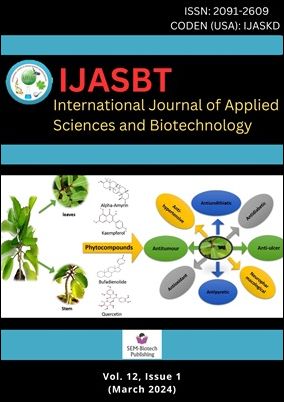Karyomorphology of Seven Different Angiospermic Plants
DOI:
https://doi.org/10.3126/ijasbt.v12i1.64328Keywords:
Karyomorphology, Chromosome number, Angiosperm, Asteraceae, Aceto-orcienAbstract
The focus of this study is on the karyomorphological examination of seven angiospermic plants: Centaurea cyanus L. belonging to the Cynareae tribe; Coreopsis grandiflora Nutt. ex Chapm. and Eclipta prostrata (Linn.) Linn. from the Heliantheae tribe; Eupatorium adenophorum Spreng from the Eupatorie tribe; Gnaphalium affine D. Don. from the Inuleae tribe; Rhynchospermum verticillatum Reinw. from the Astereae tribe; and Tridax procumbens L within the Asteraceae family. Cytological analysis was used to assess the chromosome count and karyomorphology of all seven plants studied in central Nepal. The somatic chromosomal number found in this inquiry was 2n=24 for Centaurea cyanus, which has the karyotype formula M12+ m6+sm2+ st4. Similarly, 2n=26 was found for Coreopsis grandiflora, which has the karyotype formula M14+sm12 and 2n=22 for Eclipta prostrata which has the karyotype formula M14+sm6+st2. The karyotype formula for Eupatorium adenophorum is M4+m12+sm26+st8 and 2n=50, while for Gnaphalium affine, it is M10+sm4, with a 2n=14 value. The karyotype formula for Rhynchospermum verticillatum is M4+ m8+ sm6 with 2n = 18. For Tridax procumbens L, 2n = 26 whose karyotype formula is M18+m4+sm2+ st2.The examined taxa's total length varied from 0.3 µm to 2.6 µm.
Int. J. Appl. Sci. Biotechnol. Vol 12(1): 8-18.
Downloads
Downloads
Published
How to Cite
Issue
Section
License
Copyright (c) 2024 International Journal of Applied Sciences and Biotechnology

This work is licensed under a Creative Commons Attribution-NonCommercial 4.0 International License.




